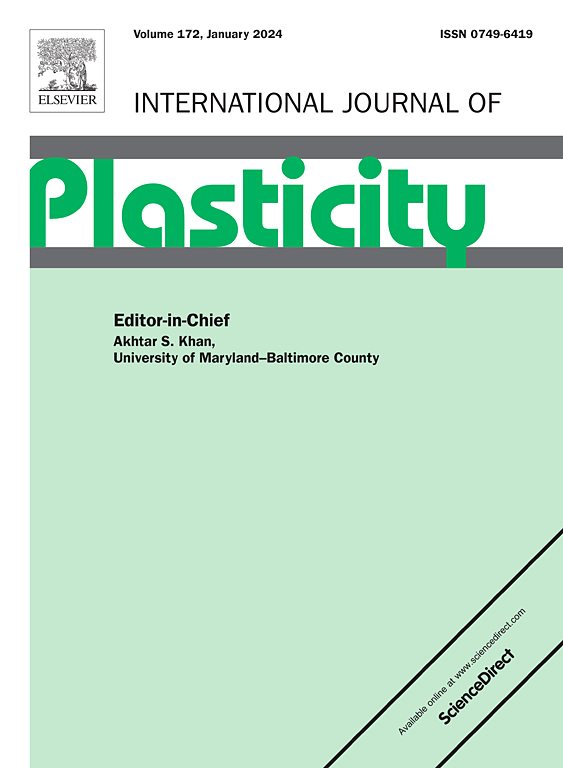Hydrostatic pressure tuned grain boundary mobility in polycrystalline metals
IF 12.8
1区 材料科学
Q1 ENGINEERING, MECHANICAL
引用次数: 0
Abstract
Grain boundary (GB) plasticity plays a pivotal role in the mechanical behaviours of polycrystalline materials. The kinetics and deformation of GBs depend on both GB geometry and local stress states. While classic GB theories primarily focus on shear-driven GB kinetics, the fundamental mechanism by which hydrostatic pressure influences GB plasticity remains largely unclear, despite the evidence that polycrystalline materials subjected to substantial pressures can exhibit distinct mechanical properties. Here, we investigate pressure-tuned GB kinetics in polycrystalline metals through a series of atomistic simulations combined with experimental validations. We demonstrate that under constant temperature annealing, the application of pressure can reduce GB mobility and thus the rate of grain growth, which originates from the pressure-enhanced activation energies for disconnection nucleation and gliding. More importantly, pressure can shift GB deformation mechanism from disconnection-annihilation-mediated GB migration to disconnection-accumulation-mediated GB rotation, resulting in an asymmetry-to-symmetry GB structural transformation and generating a large volume of special GBs. An energetic model based on pressure-dependent disconnection dynamics is proposed to interpret the pressure-tuned GB mobility, offering insights into the understanding of pressure-assisted grain growth retardation in polycrystalline metals widely reported in the literature.

静水压力调节多晶金属晶界迁移率
晶界塑性在多晶材料的力学行为中起着举足轻重的作用。GB的动力学和变形取决于GB的几何形状和局部应力状态。虽然经典的GB理论主要关注剪切驱动的GB动力学,但静水压力影响GB塑性的基本机制仍不清楚,尽管有证据表明多晶材料在大压力下可以表现出不同的力学性能。在这里,我们通过一系列原子模拟结合实验验证,研究了多晶金属中压力调谐的GB动力学。研究表明,在常温退火条件下,施加压力可以降低GB迁移率,从而降低晶粒的生长速度,这是由于压力增强了断开形核和滑动的活化能。更重要的是,压力可以使GB变形机制从断裂湮灭介导的GB迁移转变为断裂积累介导的GB旋转,导致不对称到对称的GB结构转变,产生大量的特殊GB。提出了一种基于压力相关断开动力学的能量模型来解释压力调谐的GB迁移率,为理解文献中广泛报道的多晶金属中压力辅助晶粒生长迟缓提供了见解。
本文章由计算机程序翻译,如有差异,请以英文原文为准。
求助全文
约1分钟内获得全文
求助全文
来源期刊

International Journal of Plasticity
工程技术-材料科学:综合
CiteScore
15.30
自引率
26.50%
发文量
256
审稿时长
46 days
期刊介绍:
International Journal of Plasticity aims to present original research encompassing all facets of plastic deformation, damage, and fracture behavior in both isotropic and anisotropic solids. This includes exploring the thermodynamics of plasticity and fracture, continuum theory, and macroscopic as well as microscopic phenomena.
Topics of interest span the plastic behavior of single crystals and polycrystalline metals, ceramics, rocks, soils, composites, nanocrystalline and microelectronics materials, shape memory alloys, ferroelectric ceramics, thin films, and polymers. Additionally, the journal covers plasticity aspects of failure and fracture mechanics. Contributions involving significant experimental, numerical, or theoretical advancements that enhance the understanding of the plastic behavior of solids are particularly valued. Papers addressing the modeling of finite nonlinear elastic deformation, bearing similarities to the modeling of plastic deformation, are also welcomed.
 求助内容:
求助内容: 应助结果提醒方式:
应助结果提醒方式:


